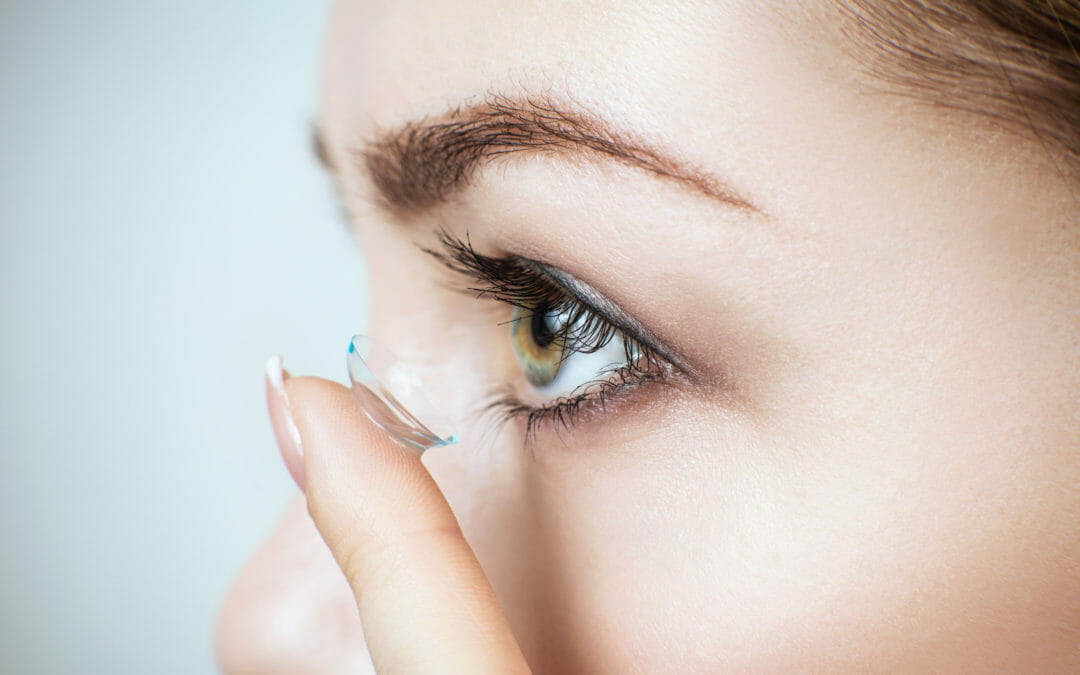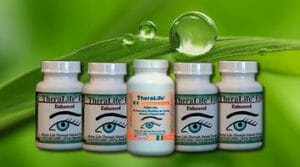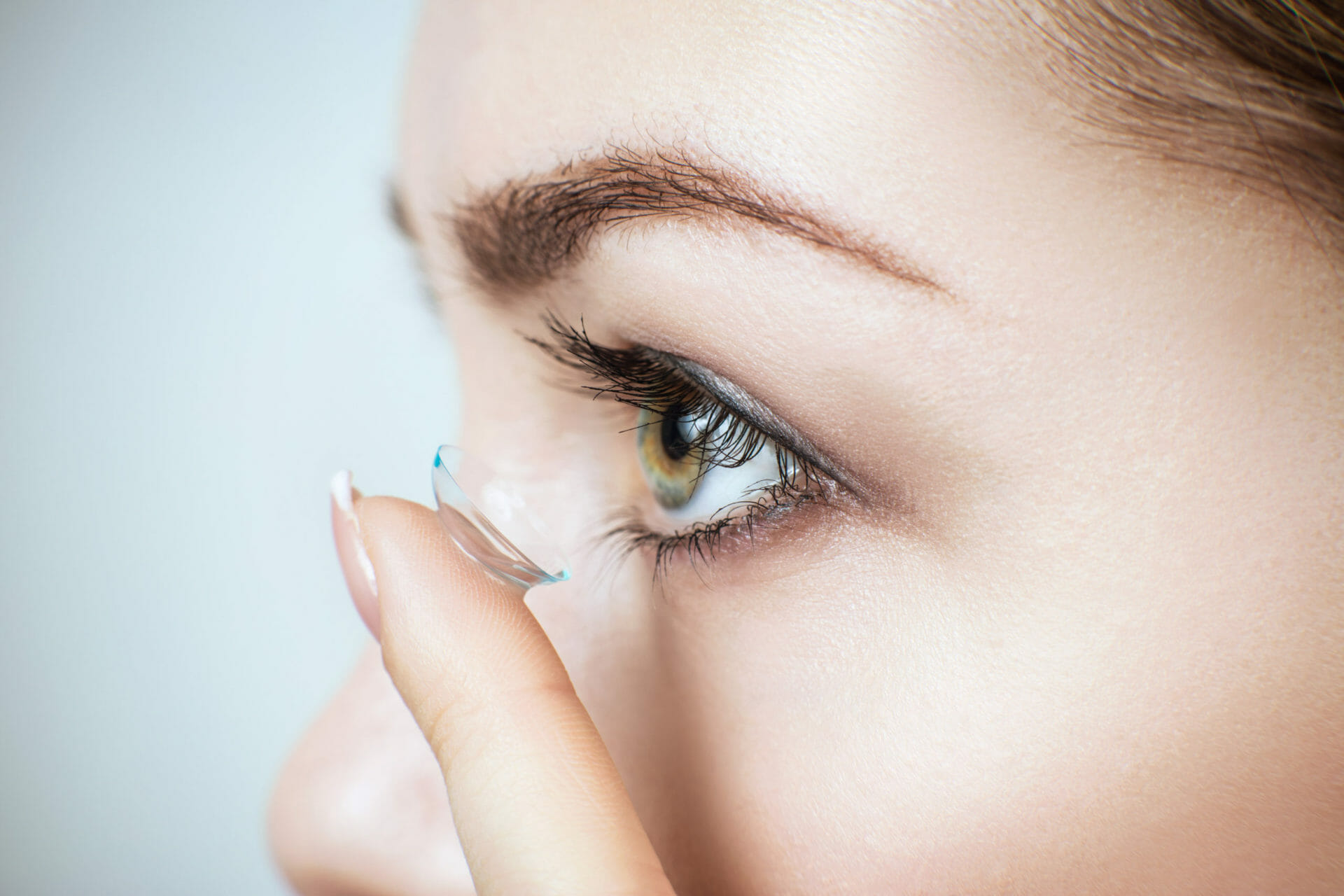More than 30 million people in the United States wear contact lenses. People prefer contacts to eyeglasses because they’re more convenient, and they correct your vision without changing your appearance. Usually, you can barely feel that you’re wearing them.
But if you develop a condition called dry eye syndrome, contact lenses can become uncomfortable. This occurs when your eyes don’t produce enough tears to keep your eyes lubricated and comfortable.
Treat Your Dry Eyes So You Can Wear Contact Lenses
Theralife treats dry eyes from inside out – Orally. No more drops. Clinically proven to work.
What is dry eye syndrome?
About 60 million Americans experience dry eye syndrome. Causes can include:
- Damage to the tear glands around the eyes, such as blepharitis and meibomian gland dysfunction (MGD).
- Damage to or disease of the skin around the eyes- e.g., eczema, psoriasis.
- Diseases, such as Sjogren’s syndrome and other autoimmune conditions
- Medicines, such as antihistamines, certain antidepressants, blood pressure medications, and birth control pills
- Hormone changes that can occur with menopause
- Dry eye can also be associated with allergies and with aging eyes
Wearing contact lenses for long periods can cause dry eyes by aiding tears to evaporate faster. Half of contact lens wearers develop contact lens-related dry eyes.
Dry eye causes pain, burning, or a gritty feeling. Some people experience blurred vision and become light-sensitive. With dry eye, you may feel incredibly uncomfortable while wearing your contact lenses.
You don’t have to give up wearing contact lenses if you have a dry eye. Treating the cause of dry eye or changing to a different type of lens can help.
Options for treatment of dry eyes
TheraLife can help
- TheraLife has an oral dry eye treatment that works when drops don’t. TheraLife Eye capsules restore and revive tear secretion glands so you can relieve your dry eyes with your own tears. To learn more, click here.
- Eye drops – Your doctor may recommend lubricating eye drops if your eyes aren’t producing enough tears. If a medication you’re taking is the cause, you may need to switch.
- Punctual Plugs – There’s a procedure to plug the drain system in your eyes so that more moisture stays in your eyes. This procedure may be offered in severe cases.
What to do for contact lens dry eyes
If the problem is with your lenses, you may have to try a different kind. Here are a few options.
- Soft Contact Lenses — Soft contacts are made of hydrogel, a material that contains water. While soft lenses are typically disposable, some manufacturers offer extended-wear lenses that can be reused for up to 30 days.
- Silicone-Based Hydrogel Contact Lenses — These are similar to hydrogel lenses but retain moisture far longer than regular hydrogel contacts.
- Gas-Permeable Contact Lenses — This type of contact lens is more rigid but allows oxygen to reach the eye. Orthokeratology lenses are made from a similar material.
Lens materials
Different types of contact lens materials are available. Soft contact lenses are made of a flexible plastic that allows oxygen to pass through to the eye. Rigid gas-permeable contact lenses are made of a harder material, but they also allow oxygen to reach the eye.
Soft lenses are made of hydrogel, which contains water. There are disposable soft lenses that can be worn for a day and then thrown out. Extended wear soft lenses can be reused for up to 30 days.
Changing your contact lenses every day prevents protein deposits, which can make your eyes feel even drier. If you experience problems with dry eyes, you may want to try disposable lenses.
You may also consider switching to a silicone-based hydrogel lens. These types of lenses do not allow water to evaporate as readily as others. They may reduce dry eye better than regular hydrogel contacts.
Proclear is the only brand of disposable lenses that are FDA-approved to help reduce the sensation of dry eye discomfort. It contains phosphorylcholine, which is supposed to attract water and keep your eyes feeling moist.
Lens water content
Soft contact lenses are categorized by how much water they contain.
High-water content lenses are more likely to cause dry eyes than those with low water content. They tend to send more moisture to the eye when you first put them in but can dry out faster. You may need to try lenses with different water contents until you find the one that works for you.
Lens size
Most contact lenses measure about 9 millimeters across. They cover just the iris, the colored part of the eye.
Scleral contact lenses typically measure 15 to 22 millimeters across. They cover part of the white area of the eye, known as the sclera. Scleral lenses are gas-permeable, meaning they let oxygen reach the eye’s surface. Some people report an improvement in symptoms with this type of lens.
A change in solutions
Sometimes the problem is not with your contact lenses but with the solution you’re using to clean them. Some solutions contain preservatives that can irritate your eyes and leave them dry. Others have materials that may not be compatible with specific soft contact lenses and can cause a reaction.
Care for your contact lenses
There are a variety of options to help you relieve dry eyes.
Switching to a different type of contact lens is an excellent place to start. Taking care of your lenses is another crucial step. Keep them clean and change them as recommended. Only wear your lenses for the amount of time your eye doctor prescribes.
Moisten your eyes with rewetting drops before putting in your contact lenses. Use the drops throughout the day, so your eyes stay moist. When you’re in an arid environment, like a heated room during winter, you may need to use drops more often. If your eyes are sensitive, try a preservative-free brand of eye drop.
You may need to temporarily stop wearing your contacts if you’re still having problems after trying different lenses and solutions. Rehydrate your eyes with preservative-free tears for a few days to let your eyes recover. Follow your doctor’s advice before trying the contacts again.
Frequently Asked Questions
Can I wear contact lens if I have dry eyes?
Yes, you can wear contact lenses if you have dry eyes. Keep your eyes moist- take Theralife Eye capsules to help you produce your own tears. You can also use eye drops to keep your contact lenses wet.
How do you keep dry eyes moist with contacts?
Clean your lenses often to remove protein deposit to reduce irritation. Take TheraLife Eye capsules to help you make your own tears to relieve dry eyes while wearing contact lenses
Why are daily contacts better for dry eyes?
Conclusion
While the future may see the contact lens industry incorporating lubricin or other measures to reduce friction between the ocular surface and the contact lens, current evidence-based measures need to be implemented to overcome contact lens dry eyes. Importantly, each person needs to be reviewed for the risk factors of contact lens dry eyes, with these being addressed as early as possible in order to minimize the number of people resorting to contact lens discontinuation.
References
- Stapleton F, Keay L, Jalbert I, Cole N. The epidemiology of contact lens related infiltrates. Optom Vis Sci. 2007;84:257–272.
- Pritchard N, Fonn D, Brazeau D. Discontinuation of contact lens wear: a survey. Int Contact Lens Clin. 1999;26:157–162.
- Begley CG, Chalmers RL, Mitchell GL, et al. Characterization of ocular surface symptoms from optometric practices in North America. Cornea. 2001;20:610–618.
- Riley C, Young G, Chalmers R. Prevalence of ocular surface symptoms, signs, and uncomfortable hours of wear in contact lens wearers: the effect of refitting with daily-wear silicone hydrogel lenses (senofilcon a) Eye Contact Lens. 2006;32:281–286.
- Kaštelan S, Lukenda A, Salopek-Rabatić J, Pavan J, Gotovac M. Dry eye symptoms and signs in long-term contact lens wearers. Coll Antropol. 2013;37:199–203.
- Reddy SC, Ying KH, Theng LH, How OT, Fu-Xiang K, bin Mohamed Sikander MM. A survey of dry eye symptoms in contact lens wearers and non-contact lens wearers among university students in Malaysia. J Clin Exp Ophthalmol. 2016;7:522.
- Chalmers RL, Young G, Kern J, Napier L, Hunt C. Soft contact lens-related symptoms in North America and the United Kingdom. Optom Vis Sci. 2016;93:836–847.
- Nichols KK, Redfern RL, Jacob JT, et al. The TFOS International Workshop on Contact Lens Discomfort: report of the definition and classification subcommittee. Invest Ophthalmol Vis Sci. 2013;54:TFOS14–TFOS19.
- Nichols JJ, Jones L, Nelson JD, et al. The TFOS International Workshop on Contact Lens Discomfort: introduction. Invest Ophthalmol Vis Sci. 2013;54:TFOS1–TFOS6.
- Morgan PB, Woods CA, Knajian R, et al. International contact lens prescribing in 2007. Contact Lens Spectrum. 2008;22:34.
- Efron N, Jones L, Bron AJ, et al. The TFOS International Workshop on Contact Lens Discomfort: report of the contact lens interactions with the ocular surface and adnexa subcommittee. Invest Ophthalmol Vis Sci. 2013;54:TFOS98–TFOS122.
- Gipson IK. Distribution of mucins at the ocular surface. Exp Eye Res. 2004;78:379–388.
- Doughty MJ. Contact lens wear and the goblet cells of the human conjunctiva – a review. Cont Lens Anterior Eye. 2011;34:157–163.
- Sapkota K, Franco S, Sampaio P, Lira M. Effect of three months of soft contact lens wear on conjunctival cytology. Clin Exp Optom. 2016;99:336–341.
- Colorado LH, Alzahrani Y, Pritchard N, Efron N. Time course of changes in goblet cell density in symptomatic and asymptomatic contact lens wearers. Invest Ophthalmol Vis Sci. 2016;57:2560–2566.
- Knop E, Brewitt H. Induction of conjunctival epithelial alterations by contact lens wearing. A prospective study. Ger J Ophthalmol. 1992;1:125–134.
- Carracedo G, Martin-Gil A, Fonseca B, Pintor J. Effect of overnight orthokeratology on conjunctival goblet cells. Cont Lens Anterior Eye. 2016;39:266–269.
- Doughty MJ. On the variability in goblet cell density in human bulbar conjunctival samples collected by impression cytology with millicell-CM biopore membrane units. Curr Eye Res. 2016;41:1393–1399.
- Alzahrani Y, Colorado LH, Pritchard N, Efron N. Longitudinal changes in Langerhans cell density of the cornea and conjunctiva in contact lens-induced dry eye. Clin Exp Optom. 2016;100(1):33–40.
- Doughty MJ. Contact lens wear and the development of squamous metaplasia of the surface cells of the conjunctiva. Eye Contact Lens. 2011;37:274–281.
- Doughty MJ. Reliability of nucleus-to-cell and nucleus-to-cytoplasm calculations for conjunctival impression cytology specimens. Curr Eye Res. 2012;37:583–591.
- Doughty MJ. Sampling area selection for the assessment of goblet cell density from conjunctival impression cytology specimens. Eye Contact Lens. 2012;38:122–129.
- Doughty MJ. Assessment of goblet cell orifice distribution across the rabbit bulbar conjunctiva based on numerical density and nearest neighbors analysis. Curr Eye Res. 2013;38(2):237–251.
- Nelson JD, Wright JC. Conjunctival goblet cell densities in ocular surface disease. Arch Ophthalmol. 1984;102:1049–1051.
- Bergmanson JPG, Tukler J, Leach NE, Alabdelmoneam M, Miller WL. Morphology of contact lens-induced conjunctival epithelial flaps: a pilot study. Cont Lens Anterior Eye. 2012;35:185–188.
- Santodomingo-Rubido J, Wolffsohn J, Gillmartin B. Conjunctival epithelial flaps with 18 months of silicone hydrogel contact lens wear. Eye Contact Lens. 2008;34:35–38.
- Graham AD, Truong TN, Lin MC. Conjunctival epithelial flap in continuous contact lens wear. Optom Vis Sci. 2009;86:324–331.
- Guillon M, Maissa C. Bulbar conjunctival staining in contact lens wearers and non lens wearers and its association with symptomatology. Cont Lens Anterior Eye. 2005;28:67–73.
- Markoulli M, Francis IC, Yong J, et al. A Histopathological study of bulbar conjunctival flaps occurring in 2 contact lens wearers. Cornea. 2011;30(9):1037–1041.
- Løfstrøm T, Kruse A. A conjunctival response to silicone hydrogel lens wear. Contact Lens Spectrum. 2005 Sep;
- Ozkan J, Ehrmann K, Meadows D, Holden B, de la Jara PL. Lens parameter changes under in vitro and ex vivo conditions and their effect on the conjunctiva. Cont Lens Anterior Eye. 2013;36(4):171–175.
- Mimura T, Usui T, Yamamoto H, et al. Conjunctivochalasis and contact lenses. Am J Ophthalmol. 2009;148:20–25.e21.
- Lakkis C, Brennan NA. Bulbar conjunctival fluorescein staining in hydrogel contact lens wearers. CLAO J. 1996;22:189–194.
- Maldonado-Codina C, Morgan PB, Schnider CM, Efron N. Short-term physiologic response in neophyte subjects fitted with hydrogel and silicone hydrogel contact lenses. Optom Vis Sci. 2004;81:911–921.
- Pult H, Purslow C, Berry M, Murphy PJ. Clinical tests for successful contact lens wear: relationship and predictive potential. Optom Vis Sci. 2008;85:E924–E929.
- Fukui M, Yamada M, Akune Y, Shigeyasu C, Tsubota K. Fluorophotometric analysis of the ocular surface glycocalyx in soft contact lens wearers. Curr Eye Res. 2016;41:9–14
- Ablamowicz AF, Nichols JJ. Ocular surface membrane-associated mucins. Ocul Surf. 2016;14:331–341.
- Korb DR, Greiner JV, Herman JP, et al. Lid-wiper epitheliopathy and dry-eye symptoms in contact lens wearers. CLAO J. 2002;28:211–216.
- Schulze MM, Srinivasan S, Hickson-Curran SB, et al. Lid wiper epitheliopathy in soft contact lens wearers. Optom Vis Sci. 2016;93:943–954.
- Varikooty J, Srinivasan S, Subbaraman L, et al. Variations in observable lid wiper epitheliopathy (LWE) staining patterns in wearers of silicone hydrogel lenses. Cont Lens Anterior Eye. 2015;38:471–476.
- Nichols JJ, Lievens CW, Bloomenstein MR, Liu H, Simmons P, Vehige J. Dual-polymer drops, contact lens comfort, and lid wiper epitheliopathy. Optom Vis Sci. 2016;93:979–986.
- Deng Z, Wang J, Jiang H, et al. Lid wiper microvascular responses as an indicator of contact lens discomfort. Am J Ophthalmol. 2016;170:197–205.
- Alzahrani Y, Colorado L, Pritchard N, Efron N. Inflammatory cell upregulation of the lid wiper in contact lens dry eye. Optom Vis Sci. 2016;93:917–924.
- Yamamoto Y, Shiraishi A, Sakane Y, Ohta K, Yamaguchi M, Ohashi Y. Involvement of eyelid pressure in lid-wiper epitheliopathy. Curr Eye Res. 2016;41(2):171–178.
- Jie Y, Xu L, Wu Y, Jonas J. Prevalence of dry eye among adult Chinese in the Beijing Eye Study. Eye. 2009;23:688–693.
- Doughty MJ, Fonn D, Richter D, Simpson T, Caffery B, Gordon K. A patient questionnaire approach to estimating the prevalence of dry eye symptoms in patients presenting to optometric practices across Canada. Optom Vis Sci. 1997;74:624–631.
- Lu P, Chen X, Liu X, et al. Dry eye syndrome in elderly Tibetans at high altitude: a population-based study in China. Cornea. 2008;27:545–551.
- Schaumberg DA, Dana R, Buring JE, Sullivan DA. Prevalence of dry eye disease among US men: estimates from the Physicians’ Health Studies. Arch Ophthalmol. 2009;127:763–768. [PMC free article]
- Schaumberg DA, Sullivan DA, Buring JE, Dana MR. Prevalence of dry eye syndrome among US women. Am J Ophthalmol. 2003;136:318–326.
- Moss SE, Klein R, Klein BE. Prevalence of and risk factors for dry eye syndrome. Arch Ophthalmol. 2000;118:1264–1268.
- Nichols KK, Nichols JJ, Mitchell GL. The lack of association between signs and symptoms in patients with dry eye disease. Cornea. 2004;23:762–770.
- Viso E, Rodríguez-Ares MT, Abelenda D, Oubiña B, Gude F. Prevalence of asymptomatic and symptomatic meibomian gland dysfunction in the general population of Spain. Invest Ophthalmol Vis Sci. 2012;53:2601–2606.
- Nichols KK, Foulks GN, Bron AJ, et al. The International Workshop on Meibomian Gland Dysfunction: executive summary. Invest Ophthalmol Vis Sci. 2011;52:1922–1929.
- Richdale K, Sinnott LT, Skadahl E, Nichols JJ. Frequency of and factors associated with contact lens dissatisfaction and discontinuation. Cornea. 2007;26:168–174.
- Henriquez AS, Korb DR. Meibomian glands and contact lens wear. Br J Ophthalmol. 1981;65:108–111.
- Arita R, Itoh K, Inoue K, Kuchiba A, Yamaguchi T, Amano S. Contact lens wear is associated with decrease of meibomian glands. Ophthalmology. 2009;116:379–384.
- Alghamdi WM, Markoulli M, Holden BA, Papas EB. Impact of duration of contact lens wear on the structure and function of the meibomian glands. Ophthalmic Physiol Opt. 2016;36:120–131.
- Nichols JJ, Sinnott LT. Tear film, contact lens, and patient-related factors associated with contact lens-related dry eye. Invest Ophthalmol Vis Sci. 2006;47:1319–1328.
- Cox SM, Berntsen DA, Chatterjee N, et al. Eyelid margin and meibomian gland characteristics and symptoms in lens wearers. Optom Vis Sci. 2016;93:901–908.
- Randon M, Liang H, El Hamdaoui M, et al. In vivo confocal microscopy as a novel and reliable tool for the diagnosis of Demodex eyelid infestation. Br J Ophthalmol. 2015;99:336–341.
- Rufli T, Mumcuoglu Y. The hair follicle mites Demodex folliculorumand Demodex brevis: biology and medical importance. A review. Dermatologica. 1981;162:1–11.
- Tarkowski W, Moneta-Wielgos J, Mlocicki D. Demodex sp. as a potential cause of the abandonment of soft contact lenses by their existing users. Biomed Res Int. 2015;2015:259109.
- Hom MM, Mastrota KM, Schachter SE. Demodex. Optom Vis Sci. 2013;90:e198–e205.
- Craig JP, Willcox MD, Argueso P, et al. The TFOS International Workshop on Contact Lens Discomfort: report of the contact lens interactions with the tear film subcommittee. Invest Ophthalmol Vis Sci. 2013;54:TFOS123–TFOS156.
- Best N, Drury L, Wolffsohn JS. Predicting success with silicone-hydrogel contact lenses in new wearers. Cont Lens Anterior Eye. 2013;36:232–237.
- Guillon M, Dumbleton KA, Theodoratos P, et al. Association between contact lens discomfort and pre-lens tear film kinetics. Optom Vis Sci. 2016;93:881–891.
- Efron N. Contact lens wear is intrinsically inflammatory. Clin Exp Optom. 2017;100:3–19.
- Granger DN, Senchenkova E. Inflammation and the Microcirculation.San Rafael (CA): Morgan & Claypool Life Sciences; 2010.
- The definition and classification of dry eye disease: report of the Definition and Classification Subcommittee of the International Dry Eye WorkShop (2007) Ocul Surf. 2007;5:75–92. ]






